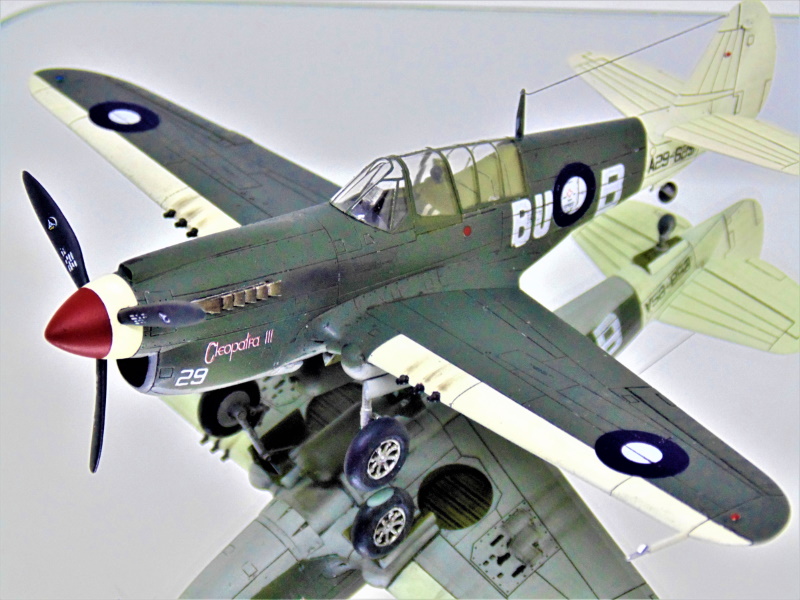1⁄72Building the RAAF Curtiss P-40N Warhawk
The Subject
P-40N (manufactured 1943–44), the final production model. The P-40N featured a stretched rear fuselage to counter the torque of the more powerful, late-war Allison engine, and the rear deck of the cockpit behind the pilot was cut down at a moderate slant to improve rearward visibility. A great deal of work was also done to try and eliminate excess weight to improve the Warhawk's climb rate. Early N production blocks dropped a .50 in (12.7 mm) gun from each wing, bringing the total back to four; later production blocks reintroduced it after complaints from units in the field. Supplied to Commonwealth air forces as the Kittyhawk Mk IV. A total of 553 P-40Ns were acquired by the Royal Australian Air Force, making it the variant most commonly used by the RAAF. Subvariants of the P-40N ranged widely in specialization from stripped down four-gun "hot rods" that could reach the highest top speeds of any production variant of the P-40 (up to 380 mph), to overweight types with all the extras intended for fighter-bombing or even training missions. The 15,000th P-40 was an N model decorated with the markings of 28 nations that had employed any of Curtiss-Wright's various aircraft products, not just P-40s. "These spectacular markings gave rise to the erroneous belief that the P-40 series had been used by all 28 countries."[98] Since the P-40N was by 1944 used mainly as a ground attack aircraft in Europe, it was nicknamed B-40 by pilots.[99] Survivors redesignated as ZF-40N in June 1948. ~wikipedia~Introduction
Lately, for some reason, there seams to be more stories about Australian and New Zealand efforts in the Pacific and especially late in the war. A fellow modeler had sent some kits he was never going to build and one had markings from the 80th squadron early 1945. Yes you guessed it, he sent this kit at the same time these accounts in New Guinea cropped up, hence the subject. Besides everyone does a shark's mouth and don't care for sharks... unless one's on a plate with french fries and coleslaw.The Kit
The Academy 1/72 P-40N/M kit gives you the option of three variants with four markings. The fit is mostly good, save for some areas I'll address, with only a little sanding and filling needed. The surface detail is great for the scale and the clear parts are super! The decals are from 1999 and a fellow modeler warned me they were brittle, thus I painted them with Microscale decal film. Instructions are very easy to follow and overall the project went together very quickly... something I'd recommend to anyone.The Build
I began test fitting the cockpit floor with the left and right half because there seamed to be something not right with back armor plate. There was no real positive fit, so I cemented it, put it together and let it set for later. And yes, I do reuse my tape... shocking, it's the Scottish blood.After the parts were all prepped Vallejo model air interior green was sprayed with Tamiya olive drab for the seat as per the instructions. I hand made some belts out of tape and gave some details an oil wash with Abteilung 502 smoke. There is a slight fit issue with the radiator separator part that was not fixed, yet thankfully it's hardly noticeable. Next was some detail painting which included the instrument panel since, oddly, it did not come with a decal.
You will need a few clamps to help but only to hurry the build along. Holding the parts will do just fine otherwise. The base of cockpit has a pin to hold in place the the floor to the fuselage sides, however, it is 1 mm too short. A tiny bit of plastic solves the issue and doesn't interfere with the wings going on. The lower nose and front area of the wings have a nasty step that needs sanding but that wasn't a big deal since the plastic is very good quality.
Once that was flush I turned to re-scibing the lines then little things such as hollowing the guns out and sanding weight into the tires. I'll admit to missing, as should Academy, the air holes at the front at the wing root, they should be round. There was a thought to run a few lines of rivets but figured it would look out of scale and with a wash too dirty. I wanted the theme for this aircraft to be "First Flight First Fight" (insert another F expletive if you want to be colloquially period correct... no kidding).
My friend Krister from Sweden had also sent the Eduard mask set. I am not a huge fan of Eduard masks and these were no exception. The dye cutter must have been on its last legs when this one was done because the corners needed to be cut in far too many places to have any right in asking for peoples money. Word to the wise ALWAYS run your new blade along the edge before you remove them. That's my little rant so on we go. As mentioned the clear parts are brilliant with great frame detail and a perfect fit. Almost made me lament not adding some scratch built detail in the cockpit, which strangely enough I usually do. Naturally a few coats of interior green went down first then the skin color with tape on the inside for the over-spray.
After painting the wheels wells and tail wheel area those, along with the nose and cockpit, were masked then primed with AK Micro Primer Filler. Absolutely love the stuff. It bites well and is sand-able in a few a hours, although they say wait twelve. Insignia white looks much better than bright white so that was my choice not the instructions. That and the RAF dark green, light sea grey and red spinner cone came from Mission Models Paint.
Once the Tamiya clear coat had hardened the suspect decals went on with only one tiny flaw, my fault, with the lower corner of the first "B". Again, using the Microscale Liquid Decal Film saved the day. Then the decals were sprayed with a clear coat to ready them for the dark dirt clay wash.
I chose Tamiya's dull coat for the look because it is not completely dull and lends to the look of this Warhawk's theme. Landing gear details were next going on without a hitch. I PVA glued the canopy after a good polish, added the pitot tube, antenna and some EZ-Line fine for the wire. Next came painting the Nav. lights on the wings and vertical stabilizer. Finally a touch of weathering here and there with rust and soot pigments and the project was complete.
Wrap Up
And there you have it. The Academy 1/72 Curtiss-Wright P-40N Warhawk in late WWII RAAF 80th Squadron. As one fellow modeler noted, "It looks much bigger, like a 1/48!" and that's because of the kit being so well detailed... plus a few little things here and there. Thank you for spending some time with me and don't hesitate to pick up a 1/72 and have some fun.When shopping for this kit please mention you read an article on KitMaker Network AeroScale.
Copyright ©2021 by HG Barnes. Images also by copyright holder unless otherwise noted. The views and opinions expressed herein are solely the views and opinions of the authors and/or contributors to this Web site and do not necessarily represent the views and/or opinions of AeroScale, KitMaker Network, or Silver Star Enterrpises. Images also by copyright holder unless otherwise noted. Opinions expressed are those of the author(s) and not necessarily those of AeroScale. All rights reserved. Originally published on: 2019-12-09 00:00:00. Unique Reads: 5335





.JPG)
.JPG)
.JPG)
.JPG)
.JPG)
.JPG)
.JPG)
.JPG)
.JPG)
.JPG)
.JPG)
.JPG)
.JPG)
.JPG)
.JPG)
.JPG)
.JPG)
.JPG)
.JPG)
.JPG)
.JPG)
.JPG)
.JPG)
.JPG)
.JPG)
.JPG)
.JPG)
.JPG)
.JPG)
.JPG)
.JPG)
.JPG)
.JPG)
.JPG)
.JPG)
.JPG)




